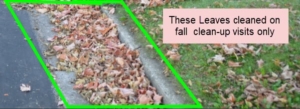
Our Lawns: “To Treat” or “Not to Treat”, and what about Organic Options?
The goal of a turf care professional is to provide a healthy lawn with a low weed population. Healthy green fescue lawns improve the appearance and enhance the value of a property. Healthy lawns also provide significant environmental benefits.
The lawn treatment (lawn care) industry is huge in the United States and for good reason. Lawn care programs are generally inexpensive and work very well. Lawns left untreated will quickly be overrun with weeds and turf will eventually disappear. Evidence of this can be seen on roadsides and unmaintained areas at public schools.
Procedures for Maintaining a Healthy Lawn
Step 1: Establish a threshold: Property owners and managers need to decide on the ultimate goal. Is it a no tolerance policy on weeds, something in-between for maintenance, or simply no concern for a weed population? This will dictate the level of services ordered and the approach of the provider. By way of example, homeowners and fancy commercial sites generally have a “no tolerance” weed policy and may have irrigation systems. Homeowners associations and budget conscious owners take a medium approach. Schools, roadsides, and certain retail centers may have no concern for weed populations or turf health.
Step 2: Establish a cultural practice: Make sure your mowing provider cuts fescue no lower than 3.5”. The mower blade must be sharp. Consider an irrigation system for the maintained area.
Step 3: Decide on fertilizer: Too often, the quality and amount of annual fertilization is overlooked and not watched. This could be the most important element of your program. Poor fertility means poor grass, more weeds, and more chemicals. It is also an area where contractors cut corners. There are 100% organic fertilizers but Blade Runners does not recommend them. The nitrogen is not stable and tends to release all at one time. Much of this drains from the property into the Chesapeake watershed. It is important to have a large slow-release component in the fertilizer. This can be a blend of organic and traditional nitrogen product. The slow release will feed the turf slowly, remain in the soil profile, and not leach into the sewer.
Step 4: Decide on seeding: Make sure that full core aeration of the property and seeding is part of the program.
Step 5: Ensure your PH is correct and apply lime annually
Step 6: Determine the weed control approach: Notice how far down the list we are. EPA regulated herbicides do a great job and are cost effective. Organic is a buzzword of interest for all of us, especially when it involves agriculture. There are organic approaches to weeds to consider. As is the case with all products and services, we need to be sure they deliver on the organic commitment, and provide the stated results.
Organic Weed Control Products
Corn Gluten: Corn Gluten is a by-product of the wet milling process utilized to make cornstarch. Research has shown that application in the spring and fall can serve as a preventive to crabgrass. Unfortunately, it is expensive and requires 4 times as much granular product applied. The cost for corn gluten alone will be twice your total overall program including the fertilizer.
Chelated Iron Weed Controls: These can be effective on weeds but it does not kill them. It burns the surface part of the plant and does not kill the root. For this reason, the weeds re-emerge and require more treatments. The product is more expensive and corrosive to metals and equipment. Many of these products are not regulated by the EPA, and traditional weed controls are.
Mixed Products: There are numerous home remedies to be found on the internet. Many of them involve the use of vinegar and other household products. We cannot speak to how effective they are. Blade Runners is prohibited by regulation from the Virginia Department of Agriculture from making our own concoctions.
Step 7: Watch out for the sling shot: If you decide on a no-chemical weed control approach, make sure you plan to adhere to it. Understand what the results will be at the outset. In many cases, clients can take an about face when the weeds overrun the property. The result is a net increase in chemical use and cost, to bring things back in line. We see this happen in most cases where clients elect to suspend applications.
At this time, Blade Runners’ recommendation is not to use organic weed and crabgrass control products. We feel they do not produce results and are too costly. We would prefer you suspend all weed control applications and simply apply lime and fertilizer. The results will be the same and the cost much lower. With that said the industry is always changing. There may come a day when things will be different. Our ears are open to anything you bring to our attention. We are willing to examine any proposed organic alternative and let you know our thoughts.







